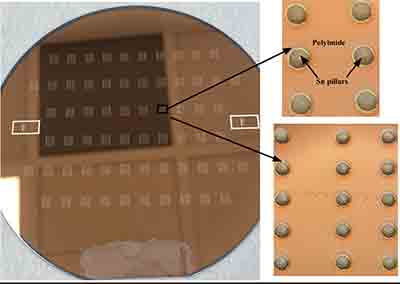I’m interested in purchasing some 4” wafers as carrier substrates to spin polyimide. Do you have any suggestions for which wafer I should use? I came across ID#1196, which seems to be a good option, but I’m not sure what is meant by “MECHANICAL GRADE, POOR QUALITY” under the description. Does that just refer to the bulk semiconductor properties, i.e. properties that don’t affect spinning polymers? Do these wafers still have well-polished, smooth, and defect-free surfaces?
Substrates Used for Polyimide Deposition
What Carrier Wafers Can Be Used to Spin Poyimide?
A senior engineer at a medical research department requested a quote for the following:
Reference #226059 for specs and pricing.
Get Your Quote FAST! Or, Buy Online and Start Researching Today!
Polyimide Coated Substrates for Novel Biosensors Devices
A device engineer researching novel biosensors requested help with the following:
For our O2 etching process, we need some etch rate monitoring wafers. Do you have some recommendation? For example, Polyimide coated wafers and we can cleave them into small pieces for etch rate monitoring purpose.
Reference #264352 for specs and pricing.
What is a Novel Biosensor?
Biosensors utilize biological components to sense and quantify  particular biochemicals. A newly created or forward-thinking biosensor incorporates contemporary improvements in technologies, substances, or methodologies.
particular biochemicals. A newly created or forward-thinking biosensor incorporates contemporary improvements in technologies, substances, or methodologies.
These biosensors typically consist of a biological recognition element, such as enzymes, antibodies, or nucleic acids, which specifically interacts with the target substance (analyte). This interaction is then translated into a measurable signal by a transducer, which can be optical, electrochemical, piezoelectric, or thermal, among others.
New biosensors are being designed to be more sensitive and precise, work faster, easier to carry around, and simpler for people to use. Biosensors are now being used in a bunch of different areas, like checking for diseases, keeping an eye on the environment, making sure food is safe to eat, and working with living organisms in cool new ways. For instance, a novel biosensor might be able to detect disease markers at much lower concentrations than previous technologies, or it might operate in a way that's more suitable for use in the field or in low-resource settings.
Polyimide Used for Microelectronics Fabrication
A Ph.D student requested a quote for the following:
Our group works in the field of microelectronics fabrication. For our recent project, we need some help with CMP processing. We are currently working on via fabrication process. We fabricate copper, tin, tin-lead vias by electroplating the material in polyimide openings. After electroplating, we need to polish over-plated vias to get a flat surface. I was wondering if you can help us with the polishing process. Please send me a quote for polishing of 6-inch and 4-inch wafers.

Optical Image of Sn Pillars
Reference #265754 for specs and pricing.
How Is Polyimide Used In Semiconductors?
In the world of computer chip making, polyimide is super important because it has some really special features that make it perfect for the job. Here's how it's typically used:
-
Dielectric Layer: Polyimide's excellent electrical insulation properties make it ideal for use as a dielectric
 layer in semiconductor devices. Polyimide acts as an electrical insulator between conducting layers in semiconductors, preventing shorts by isolating the components.
layer in semiconductor devices. Polyimide acts as an electrical insulator between conducting layers in semiconductors, preventing shorts by isolating the components. -
Passivation Layer: It serves as a protective coating over semiconductor devices. Polyimide acts like an umbrella for semiconductor devices, resisting chemicals and keeping out moisture that could otherwise harm their performance.
-
Flex Circuits: Due to its flexibility and high temperature resistance, polyimide is used in the manufacturing of flexible printed circuits. In gadgets where every inch counts or they need to bend, like smartphones, these circuits are crucial because they can twist without breaking and handle the heat.
-
Adhesive Layer: In multilayer semiconductor structures, polyimide can act as an adhesive to bind different layers together. Its stability at high temperatures ensures the integrity of these structures during the manufacturing process.
-
Temporary Wafer Carrier: During thin wafer processing, polyimide films can be used as a temporary adhesive layer to hold wafers in place. This helps in handling and processing very thin semiconductor wafers which are otherwise prone to damage.
-
Stress Buffer: In some applications, polyimide is used as a stress buffer layer to absorb the stress caused by thermal expansion mismatch between different materials in the semiconductor stack.
-
Photoresist: Special types of polyimide can be used as a photoresist in the lithography process for creating microelectronic circuits. In this use, the special traits of polyimide shine when it's hit by light during the process of sculpting tiny electric pathways.
Polyimide stands out as a key player in semiconductor creation, boasting impressive heat resistance, top-notch electrical insulation, and robustness against chemicals, which makes it essential for building complex electronic components.
Impact of Cleaning on Polyimide-Coated Silicon Surfaces
A manufacturer of cleaning chemicals for semiconductor and electronics assembly requested the following quote:
We want to investigate the influence of cleaning processes on surface properties of this coating material. Homogenous areas of Polyimide coated Si in sufficient size for testing and small quantity are hard to find, so we investigated in getting some specifically made.
We are interested in the following products: Wafer Finishes / Silicium Wafer (SI-Wafer) with the following characteristics: - Layer: PBO (Polybenzoxazol) Quality of the layer: Homogenous. Size, Thickness, Si-Orientation, Other electric parameters: Optional Quantity: 5-10 Wafers - Layer: PI (Polyimid) Quality of the layer: Homogenous. Size, Thickness, Si-Orientation, other electric parameters: Optional Quantity: 5-10 Wafers Could you please inform us about your common time of delivery and send us an offer for these products.
We are interested in the wafers, as we need reference surfaces for our customer in the semiconductor industry to conduct trials with our cleaning chemistry and impact of them on the surfaces. As we are focusing on the surface layer and have little knowledge about the specifications to manufacturer these surfaces, I would prefer to choose common and easy to manufacture parameters.
UniversityWafer, Inc. Question / Client Answers:
- Q. What is the required thickness for PBO and Pl layers?
A. Easy enough to manufacture, stable enough for “normal” process conditions. - Q. Can you deliver the polymers solutions for our processing or you require us to prepare the solutions?
A. We would need you to prepare the solutions. - Q. Do you need the silicon wafers to be covered with the SiO2 oxide before the layer deposition?
A. No, we would choose the cheaper/easier solution. - Q. Can we prepare the wafer's surface for the process using plasma or piranha chemistry?
A. Yes, if the resulting surface of the PBO/PI is flat after such preparations - Q. Can we deposit any supporting layer below the polymer layer?
A. Yes, if it is not too expensive. Does it increase the lifetime of the surfaces?
UniversityWafer, Inc. Quoted:
Item Qty. Description
GY83. 5/10 Silicon wafers, per SEMI Prime, Polyimide+Polished/Etched 3"Ø×380±25µm,
p-type Si:B[100]±0.5°, Ro=(1-20)Ohmcm,
TTV<10µm, Bow<40µm, Warp<40µm,
One-side-polished, back-side Alkaline etched (front side with Polyimide),
Matrimid 5218 Soluble Polyimide resin: ~2µm (top film),
SEMI Flat (one),
Sealed in Empak or equivalent cassette,
CofC: include film thickness measurement on the test wafer (destructive), roughness measurements in 10 points (profilometer).
Reference #254667 for specs and pricing.
Polymide Wafers for Aersol Printing
A graduate student requested a quote for the following:
I am interested in purchasing Polymide Wafers that would be used for printing with an Aerosol Printer. Could you please let me know what are the dimension options (or any other parameters) and the corresponding prices?
UniversityWafer, Inc. quotes2 kinds of Polyimide flexible film, the size is 300x200mm, and you can cut it to 25x25mm by yourself,
No. |
Product Name | Specification |
| #1 | Polyimide flexible film | Color: Transparent |
| Dimension: 300 x 200 x 0.05mm | ||
| #2 | Polyimide flexible film | Color: Tawny |
| Dimension: 300 x 200 x 0.125mm | ||
Refrence #264416 for specs and pricing.
